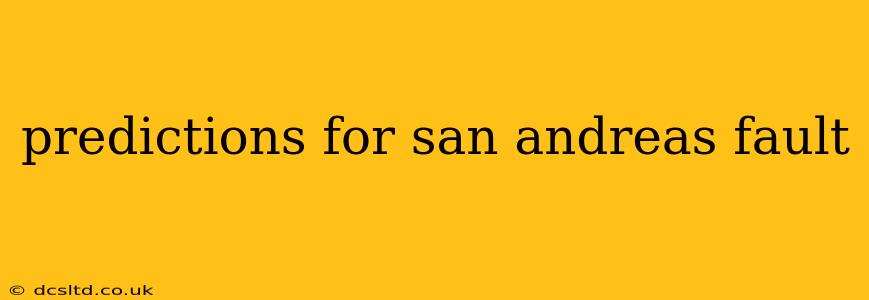The San Andreas Fault, a major continental transform fault extending roughly 800 miles through California, is a source of significant geological interest and public concern. Predicting earthquakes, however, remains a challenge for scientists worldwide. While we can't pinpoint the exact time and magnitude of future earthquakes on the San Andreas Fault, we can analyze historical data, current geological activity, and scientific models to understand the probabilities and potential impacts. This article explores the current understanding of San Andreas Fault predictions and addresses common questions.
What are the current predictions for the next major earthquake on the San Andreas Fault?
There's no single, definitive prediction for the next major earthquake on the San Andreas Fault. Scientists use probabilistic models to assess the likelihood of earthquakes of different magnitudes within a certain timeframe. These models consider factors such as the fault's history, the rate of strain accumulation, and the observed seismic activity. The United States Geological Survey (USGS) provides long-term probabilistic forecasts, indicating the chance of significant earthquakes occurring within a specific period (e.g., the next 30 years). These forecasts are updated regularly as new data become available. It's crucial to understand that these are probabilities, not certainties.
How often do major earthquakes occur on the San Andreas Fault?
The San Andreas Fault has a long history of significant earthquakes. Major ruptures—those exceeding magnitude 7—have occurred at intervals ranging from decades to centuries along different segments of the fault. Analyzing historical records and geological evidence helps scientists estimate the recurrence intervals, but these intervals are not perfectly regular. Several factors influence the timing and magnitude of future earthquakes.
What are the different segments of the San Andreas Fault and their predicted behavior?
The San Andreas Fault is not a single, uniform structure. It's comprised of numerous segments, each with its own characteristics and earthquake history. Some segments are considered more "locked" (accumulating significant strain) than others, suggesting a higher probability of a large earthquake in the future. Scientists study the movement and stress along each segment to improve their understanding of potential rupture scenarios. However, the interconnectedness of these segments also means that an earthquake on one segment could influence the likelihood of activity on adjacent segments.
What areas along the San Andreas Fault are considered most at risk?
Several areas along the San Andreas Fault are identified as having a high probability of significant future earthquake activity. These areas are often characterized by a history of large earthquakes, current high strain accumulation rates, and proximity to densely populated areas. The USGS and other research institutions regularly update hazard maps reflecting these risks. These maps are crucial tools for land-use planning, building codes, and emergency preparedness.
How do scientists predict earthquakes on the San Andreas Fault?
Predicting the exact time of an earthquake remains an elusive goal. However, scientists utilize various methods to assess the likelihood of future seismic events:
- Paleoseismology: Studying geological records to determine the timing and magnitude of past earthquakes.
- Geodetic measurements: Using GPS and other technologies to measure the rate of ground deformation across the fault.
- Seismic monitoring: Continuously monitoring seismic activity to detect changes in strain accumulation.
- Modeling: Developing computer simulations to test different scenarios and predict potential rupture patterns.
These methods provide valuable insights into the fault's behavior but cannot precisely forecast the timing of future events.
What is the potential impact of a major earthquake on the San Andreas Fault?
The potential impact of a major earthquake on the San Andreas Fault would be substantial, depending on the location, magnitude, and duration of the rupture. Potential consequences include:
- Ground shaking: Causing damage to structures, infrastructure, and lifelines.
- Fault rupture: Surface rupture can damage buildings and infrastructure directly overlying the fault.
- Landslides and ground failures: Triggered by intense shaking, leading to further damage and casualties.
- Tsunamis: While less likely along the San Andreas Fault compared to subduction zones, local tsunamis could occur if significant underwater displacement happens.
- Economic disruption: Widespread damage could significantly disrupt economic activity.
Understanding the complex interplay of factors affecting seismic activity on the San Andreas Fault is crucial for mitigating the risks associated with future earthquakes. While precise prediction remains a challenge, continued research and improved monitoring techniques are essential for enhancing our understanding of this active fault system and preparing for future seismic events. Staying informed about earthquake preparedness measures is vital for individuals and communities in earthquake-prone regions.
